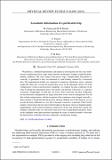| dc.contributor.author | Guttag, Mark Andrew | |
| dc.contributor.author | Karimi, Hussain H. | |
| dc.contributor.author | Falcon Beas, Claudio Moises | |
| dc.contributor.author | Reis, Pedro Miguel | |
| dc.date.accessioned | 2018-03-29T18:05:18Z | |
| dc.date.available | 2018-03-29T18:05:18Z | |
| dc.date.issued | 2018-01 | |
| dc.date.submitted | 2017-07 | |
| dc.identifier.issn | 2469-990X | |
| dc.identifier.issn | 2469-9918 | |
| dc.identifier.uri | http://hdl.handle.net/1721.1/114452 | |
| dc.description.abstract | We perform a combined experimental and numerical investigation into the static deformation of perforated elastic strips under uniform aerodynamic loading at high-Reynolds-number conditions. The static shape of the porous strips, clamped either horizontally or vertically, is quantified as they are deformed by wind loading, induced by a horizontal flow. The experimental profiles are compared to numerical simulations using a reduced model that takes into account the normal drag force on the deformed surface. For both configurations (vertical and horizontal clamping), we compute the drag coefficient of the strip, by fitting the experimental data to the model, and find that it decreases as a function of porosity. Surprisingly, we find that, for every value of porosity, the drag coefficients for the horizontal configuration are larger than those of the vertical configuration. For all data in both configurations, with the exception of the continuous strip clamped vertically, a linear relation is found between the porosity and drag. Making use of this linearity, we can rescale the drag coefficient in a way that it becomes constant as a function of the Cauchy number, which relates the force due to fluid loading on the elastic strip to its bending rigidity, independently of the material properties and porosity of the strip and the flow speed. Our findings on flexible strips are contrasted to previous work on rigid perforated plates. These results highlight some open questions regarding the usage of reduced models to describe the deformation of flexible structures subjected to aerodynamic loading. | en_US |
| dc.description.sponsorship | National Science Foundation (U.S.) (Grant CMMI-1351449) | en_US |
| dc.publisher | American Physical Society | en_US |
| dc.relation.isversionof | http://dx.doi.org/10.1103/PhysRevFluids.3.014003 | en_US |
| dc.rights | Article is made available in accordance with the publisher's policy and may be subject to US copyright law. Please refer to the publisher's site for terms of use. | en_US |
| dc.source | American Physical Society | en_US |
| dc.title | Aeroelastic deformation of a perforated strip | en_US |
| dc.type | Article | en_US |
| dc.identifier.citation | Guttag, M. et al. "Aeroelastic deformation of a perforated strip." Physical Review Fluids 3, 1 (January 2018): 014003 © 2018 American Physical Society | en_US |
| dc.contributor.department | Massachusetts Institute of Technology. Department of Civil and Environmental Engineering | en_US |
| dc.contributor.department | Massachusetts Institute of Technology. Department of Mechanical Engineering | en_US |
| dc.contributor.mitauthor | Guttag, Mark Andrew | |
| dc.contributor.mitauthor | Karimi, Hussain H. | |
| dc.contributor.mitauthor | Falcon Beas, Claudio Moises | |
| dc.contributor.mitauthor | Reis, Pedro Miguel | |
| dc.relation.journal | Physical Review Fluids | en_US |
| dc.eprint.version | Final published version | en_US |
| dc.type.uri | http://purl.org/eprint/type/JournalArticle | en_US |
| eprint.status | http://purl.org/eprint/status/PeerReviewed | en_US |
| dc.date.updated | 2018-02-07T20:55:05Z | |
| dc.language.rfc3066 | en | |
| dc.rights.holder | American Physical Society | |
| dspace.orderedauthors | Guttag, M.; Karimi, H. H.; Falcón, C.; Reis, P. M. | en_US |
| dspace.embargo.terms | N | en_US |
| dc.identifier.orcid | https://orcid.org/0000-0002-0703-4989 | |
| dc.identifier.orcid | https://orcid.org/0000-0002-0677-1020 | |
| dc.identifier.orcid | https://orcid.org/0000-0003-3984-828X | |
| mit.license | PUBLISHER_POLICY | en_US |
